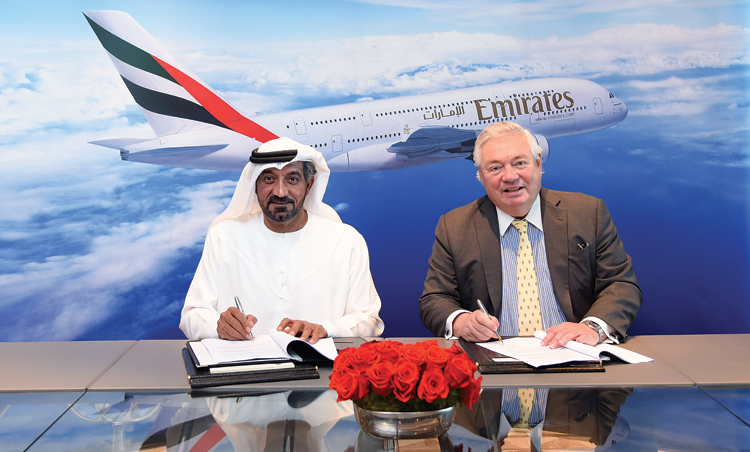Emirates-Airbus A380 Rescue OP Catches Industry Unawares
Emirates has safeguarded its interests and also at the same time, been a ‘good friend’ to Airbus without bruising its relationship with Boeing

To second guess how sweet the deal was or what great concessions Airbus made to rescue the A380 from the pages of history, is pointless. Without knowing the exact price or payment terms, the industry is only making wild assessments about the Emirate-Airbus surprise coming together on the A380.
It was not on the cards and there will still be naysayers who will feel this temporary band aid is not enough to keep the world’s biggest plane in the sky.
To an extent, the $16 billion for 20 more A380s and 16 options by Emirates, the Dubai-based airline, will keep the assembly line open and save scores of jobs while also affording Emirates Airlines the pleasure of a valid airliner and not one that has written its epitaph and become obsolete. That is a psychological no-no in aviation with a ‘what, we are flying a plane they don’t make any more’ sentiment that does not sit well on the seats.
Emirates, with more than half the manufactured behemoth double deckers in its fleet (101 as of now), has made a global imprimatur with this largest passenger aircraft and opened up long distance city pairings and literally girdled the globe. It gets no joy in dispatching its lead star to the abyss and has to weigh in with some considerations of its own even though it was ready to pay the piper at the November 2017 Dubai Airshow and walk away from further purchases unless Airbus guaranteed at least 10 years more of manufacture. Airbus delivered 15 of the planes last year, and will only deliver 12 more this year.
Last week, John Leahy, Director of Sales, Airbus who has sold over a trillion dollars worth of aircraft, had warned that even as he made his curtain call after a hugely successful career, he regretted that the A380 as an aircraft was in jeopardy if Emirates did not step up. With this last minute reprieve that caught everyone napping, he could not have expected a better farewell gift. The deal in November 2017 which fell through and started the doom boom, was for almost twice the number of confirmed orders (36); but then you do not examine too closely the texture of the rope thrown to rescue you. What Emirates has sensibly done is give its own fleet a boost by providing an oxygen tank for Airbus, a respiratory rescue operation that allows the French plane-maker time to look for fresh markets especially in the Far East and specifically in China. Again, also a break in which other nations could realise the need for the largest aircraft and rework their runways and airport facilities to accommodate it. In the end, it is a question of operating costs versus profit margins.

In the two months since the industry’s conclusion that the A380 was destined for the museum, both Airbus and Emirates would have been busy doing their sums. Emirates would have factored in the savings from the cut on the catalogue price of $445 million and change per aircraft and also seen this new order as adequate for future replacement of the older fleet between 2020 when the first delivery would be made from new batch and 2030. The older A380s would be ready for phasing out and moving into freight operations. That way, the A380 fleet would be young and strong, minimising maintenance, repair and overhaul costs.
Ergo, by helping Airbus in its struggle to save the A380, it would be helping itself without adversely affecting its bottom line.
Emirates Chairman and CEO, Sheikh Ahmed bin Saeed Al Maktoum echoed this sentiment when, at a signing of the deal in Dubai, he said that the order “will provide stability to the A380 production line.”
WHAT EMIRATES HAS SENSIBLY DONE IS GIVE ITS OWN FLEET A BOOST BY PROVIDING AN OXYGEN TANK FOR AIRBUS, A RESPIRATORY RESCUE OPERATION
Stability is the keyword and with 101 aircraft in the fleet and 41 on order, why would Emirates want the plane to tank if it can keep it afloat and not negatively hit its profitability. It has to be said that Emirates has safeguarded its interests and also at the same time, been a ‘good friend’ to Airbus without bruising its relationship with Boeing. This requires, tact, discretion, transparency and a certain deep professionalism that marks its functioning.
Whether Airbus would see this singular mouth-to-mouth resuscitation as sufficient to not just breathe life into the A380 programme globally, is a moot point. More importantly, would it give Airbus the impetus to invest in the A380 Plus upgrade for which there have been no bidders yet. The new version would decrease per passenger seat costs by 13 percent, reduce fuel consumption by four percent, increase the winglets by 15 feet, add 14 seats and two extra food trolleys for better service.
It is difficult to say at this moment; but what does make sense is that both the buyer and the maker have come onto the same page and working out a mutually satisfactory equation.
Whether it will slowdown the $15.1 purchase of 40 Boeing 787-10 Dreamliners scheduled to be inducted from 2022 to 2030, is unlikely. Two months ago, Sheikh Ahmed had said, “We see the Boeing 787 as a great complement to our Boeing 777 and Airbus A380 fleet, providing us with more flexibility to serve a range of destinations as we develop our global route network.”
That flexibility should manifest itself regardless over the next 10 years because it is the hallmark of the carrier.





